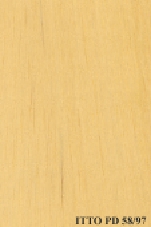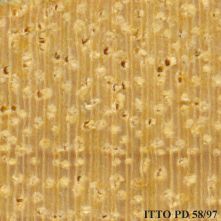
AKO (Antiaris toxicaria)
Trade Name
Ako
Scientific Name
Antiaris toxicaria Lesch.
Family
MORACEAE
Common Names
Oro (Nigeria); Ogiovu (Nigeria); Kyenkyen (Ghana); Chenchen (Ghana); Ako (Côte d`Ivoire); Akede (Côte d`Ivoire); Antiaris (United Kingdom); Antiaris (Germany); Bonkonko (Zaire); Bonkongo (Zaire); Mumaka (Uganda); Kirundu (Uganda); Mlulu (Tanzania); Mkuzu (Tanzania); Sansama (Angola); Kirundu (Angola); Upas tree; Antiaris (Papua New Guinea); Kamansi (Papua New Guinea); Upas (India); Terap (Malaysia); Nong-nong (Laos); Caay sui (Vietnam); Kapiak (Papua New Guinea); Upas (Philippines); Upas (Indonesia); Ancar (Indonesia); Tatai (Indonesia); Ipoh (Malaysia); Tasem (Sarawak); Aseik (Myanmar); Yuan (Thailand); Yang nong (Thailand)
Scientific Name Synonyms
Antiaris welwitschii Engl.; Antiaris macrophylla R. Br.; Antiaris africana Engl.; Ambora toxicaria Pers.
Description Of The Tree
Botanical Description
The tree reaches a height of 40 to 50 m, with a straight, cylindrical bole clear to 23 m in length. Trunk diameter attains from 70 up to 170 cm and is sometimes buttressed.
Natural Habitat
Antiaris toxicaria is found in primary forests and grass savanna forests.
Natural Distribution
Distributed throughout the primary forest zone of West, Central and East Africa on widely varying sites.
Wood Identification
Anatomic Description Of Wood
Wood diffuse porous. Occasionally vessels exclusively solitary (over 90%). Tangential diameter of vessel lumina 150 to 200 micras (medium). Tyloses thin walled. Non-vestured pits. Vessels per mm2 less than 6 (rare). Simple perforation plates. Vessel-ray pits sim Axial parenchyma lozenge-aliform. Occasionally prismatic crystals in non-chambered axial parenchyma cells. 5 to 8 cells per parenchyma strand. 4 to 10 rays per mm (medium). Rays non-storied. Larger rays more than 4 seriate. Body ray cells procumbent with mostly 2 to 4 rows of upright and/or square marginal cells (Kribs-II). Septate fibers present. Fibers with simple to minutely bordered pits.
-
 Wood Macro Photo Tangential Plane
Wood Macro Photo Tangential Plane
-
 Wood Micro Photo Of Transversal Section
Wood Micro Photo Of Transversal Section
Availability
Cites Status
Unrestricted
General Wood Description
Color
The heartwood is white to light yellowish white, it is not demarcated. The silver figure is barely visible.
COLOR INDEX (1=Black, 7=Light yellow,white)
7
Grain
It has highly interlocked grain; special care is needed when drying because of frequent risks of distortion.
Texture
The texture is typically medium to coarse.
Luster
The wood luster is reported to be rather low.
Natural Durability
Not durable; important risks of decay attacks at any processing step, from logs up to final products. It must receive preservative treatment. Sensible to termites attack. Heartwood is sensible to Lyctus attacks.
Natural durability index (1= Very high durability, 7=Vey low durability)
5
Internal Growth Stresses
Residual stresses are reported to be absent.
Silica Content
Silica Content: This timber is reported to have a negligible silica content. Silica contents over 0.05% may affect wood processing. Silica Value: 0.02
Resistance To Impregnation
Easy to treat with a full penetration of the preservative products using vacuum-pressure method.
Wood Physical Properties
Basic Density or Specific Gravity (O.D. weight/vol. green) (g/cm³)
0.43
Air-dry Density (Weight and volume at 12%MC) (g/cm³)
0.47
Total shrinkage Tangential (Saturated to 0%MC) (%)
6.9
Total shrinkage Radial (Saturated to 0%MC) (%)
4.1
Drying Defects
Ease of Drying: Air seasoning is rapid. Boards 25 mm thick take about 3 months to air dry. Drying Defects: Risk of cupping, shakes tend to open and knots split slightly. Kiln Schedules: Schedule recommended for Black Wattle. The timber kiln dries rapidly but marked collapse may occur in early stages of seasoning. This can be remedied by reconditioning.
Recommended Dry Kiln Schedule
FR-10
Dimensional stability ratio (Total Tangential Shrinkage %/Total Radial Shrinkage %)
1.7
Wood Chemical Properties
Wood Mechanical Properties
Bending Strength (MOR),12%MC (kgf/cm²)
595
Stiffness (MOE) 12%MC (kgf/cm²)
91758
Compression parallel to fiber 12%MC (kgf/cm²)
363
Compression perpendicular to fiber 12%MC (kgf/cm²)
40
Shear strength radial 12%MC (kgf/cm²)
56
Janka hardness (side) 12%MC (kgf)
263
Janka hardness (end grain) 12%MC (kgf)
362
Workability
Sawing
It is easy to saw.
Rotary Veneer Cutting
Suitable for slicing, also suitable for peeling if treated.
Sliced Veneer
Suitable for slicing, also suitable for peeling if treated.
Blunting Effect
Slight blunting effect; ordinary tools can be used for sawing and machining.
Machining
Machining of this species is reportedly easy.
Planing
Easy; no particular problems.
Moulding
Moderately easy; tools must be cautiously sharpened.
Boring
Moderately easy; tools must be cautiously sharpened.
Mortising
Moderately easy; tools must be cautiously sharpened.
Nailing
No particular problem.
Gluing
Glues well if basic gluing technical rules are followed.
Sanding
Easy to perform; it gives good results.
Polishing
Needs pre-coating.
Steam Bending
Steam bending is difficult.
Response To Hand Tools
No particular problems.
REFERENCED USES
End Uses Summary
HOUSING GENERAL, boards, frames, steps, panelling, fittings, FURNITURE AND CABINETS, common furniture, PLYWOOD AND VENEER, faces, Decorative veneer, PACKING, heavy packing, pallets, OTHER AND MUSICAL INSTRUMENTS, handicrafts, door core, coffin, moldings, cementboard
General Housing
- 10 - Silica in Timbers
Boards
- 13 - Dry kiln schedules for commercial woods. Temperate and tropical. Section III. Latin American (Mexico, Central, and South America) Woods–Conventional Temperatures
Frames
- 16 - Woods of the World
Steps
- 17 - Tree Conservation Database
Paneling
- 18 - W3TROPICOS Missouri Botanical Garden
Fittings
- 19 - Silica in Timbers
Furniture Cabinets
- 21 - Tropical timbers of the world. Part III-Southeast Asian and Oceanian Species.
Furniture, Common
- 23 - Handbook of Hardwoods
Panels, Veneers
- 25 - Directory of Timber Trade Malaysia
Faces
- 26 - Annual Review and Assessment of the World Timber Situation 1998-ITTO
Decorative veneer
- 28 - Ministry of Agriculture, Fisheries & Forest of Fiji
Packing
- 45 - Recopilación y Análisis de Estudios Tecnológicos de Maderas Peruanas
Heavy Packing
- 47 - Arvores Brasileiras
Pallets
- 48 - The strength properties of timbers
Handcraft
- 66 - Maderas latinoamericanas. VII. Caracteristicas anatomicas. propiedades fisicomecanicas, de secado, y tratabilidad de la madera juvenil de Cordia alliodora (Ruiz & Pav. Oken.)
Door Cores
- 76 - Descripción General y Anatómica de 105 Maderas del Grupo Andino.
Coffin
- 78 - Amazonian Timbers for the International Market
Molding
- 79 - Padronização da Nomenclatura Comercial Brasileira das Madeiras Tropicais Amazônicas, Sugestão
Cementboard
- 81 - Madeiras da Amazônia: descrição do lenho de 40 espécies ocorrentes na Floresta Nacional do Tapajós
Please Provide Information To View Producer Information